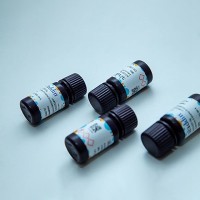【共享】Cancer cell:VEGF能抑制肿瘤细胞浸润和间质转型
丁香园论坛
1239
血管生成(Angiogenesis)是指从已有的毛细血管或毛细血管后静脉发展而形成新的血管,肿瘤血管生成的发生一方面是由于肿瘤细胞释放血管生成因子激活血管内皮细胞,促进内皮细胞的增殖和迁移,另外一方面也是因为内皮细胞旁分泌某些血管生长因子刺激肿瘤细胞的生长。肿瘤细胞和内皮细胞的相互作用自始至终贯穿于肿瘤血管生成的全过程。
通常,肿瘤新生毛细血管是在原有的血管基础上延伸扩展而形成的,其过程类似于典型的伤口愈合和胚胎形成过程。这些新生血管为不断浸润生长的原发肿瘤提供营养,反过来,肿瘤细胞在生长过程中又分泌多种物质以加速肿瘤新生毛细血管的形成。
越来越多的研究表明,良性肿瘤血管生成稀少,血管生长缓慢;而大多数恶性肿瘤的血管生成密集且生长迅速。因此,血管生成在肿瘤的发展转移过程中起到重要作用,抑制这一过程将能明显阻止肿瘤组织的发展和扩散转移。
但最新研究再次证实用贝伐单抗抑制血管内皮生长因子信号结果导致胶质母细胞瘤(GBM)小鼠模型以及GBM患者体内的肿瘤细胞更具侵袭性。相关研究论文发表在国际权威杂志Cancer cell上。研究数据表明血管内皮生长因子(VEGF)直接负调控肿瘤细胞的侵袭,通过促进蛋白酪氨酸磷酸酶1B(PTP1B)募集到间质上皮转化MET/VEGFR2杂合物中,从而抑制肝细胞生长因子依赖的MET磷酸化和肿瘤细胞迁移。
因此,血管内皮生长因子的封闭抑制反而恢复和增加GBM细胞中MET的活性。因此研究人员认为在阻断血管内皮生长因子时,同时抑制小鼠模型中肿瘤细胞的间质转型和侵袭将会大大提高导患者的生存时间
VEGF Inhibits Tumor Cell Invasion and Mesenchymal Transition through a MET/VEGFR2 Complex
Kan V. Lu, Jeffrey P. Chang, Christine A. Parachoniak, Melissa M. Pandika, Manish K. Aghi, David Meyronet, Nadezda Isachenko, Shaun D. Fouse, Joanna J. Phillips, David A. Cheresh, Morag Park, Gabriele Bergers
Inhibition of VEGF signaling leads to a proinvasive phenotype in mouse models of glioblastoma multiforme (GBM) and in a subset of GBM patients treated with bevacizumab. Here, we demonstrate that vascular endothelial growth factor (VEGF) directly and negatively regulates tumor cell invasion through enhanced recruitment of the protein tyrosine phosphatase 1B (PTP1B) to a MET/VEGFR2 heterocomplex, thereby suppressing HGF-dependent MET phosphorylation and tumor cell migration. Consequently, VEGF blockade restores and increases MET activity in GBM cells in a hypoxia-independent manner, while inducing a program reminiscent of epithelial-to-mesenchymal transition highlighted by a T-cadherin to N-cadherin switch and enhanced mesenchymal features. Inhibition of MET in GBM mouse models blocks mesenchymal transition and invasion provoked by VEGF ablation, resulting in substantial survival benefit
通常,肿瘤新生毛细血管是在原有的血管基础上延伸扩展而形成的,其过程类似于典型的伤口愈合和胚胎形成过程。这些新生血管为不断浸润生长的原发肿瘤提供营养,反过来,肿瘤细胞在生长过程中又分泌多种物质以加速肿瘤新生毛细血管的形成。
越来越多的研究表明,良性肿瘤血管生成稀少,血管生长缓慢;而大多数恶性肿瘤的血管生成密集且生长迅速。因此,血管生成在肿瘤的发展转移过程中起到重要作用,抑制这一过程将能明显阻止肿瘤组织的发展和扩散转移。
但最新研究再次证实用贝伐单抗抑制血管内皮生长因子信号结果导致胶质母细胞瘤(GBM)小鼠模型以及GBM患者体内的肿瘤细胞更具侵袭性。相关研究论文发表在国际权威杂志Cancer cell上。研究数据表明血管内皮生长因子(VEGF)直接负调控肿瘤细胞的侵袭,通过促进蛋白酪氨酸磷酸酶1B(PTP1B)募集到间质上皮转化MET/VEGFR2杂合物中,从而抑制肝细胞生长因子依赖的MET磷酸化和肿瘤细胞迁移。
因此,血管内皮生长因子的封闭抑制反而恢复和增加GBM细胞中MET的活性。因此研究人员认为在阻断血管内皮生长因子时,同时抑制小鼠模型中肿瘤细胞的间质转型和侵袭将会大大提高导患者的生存时间
VEGF Inhibits Tumor Cell Invasion and Mesenchymal Transition through a MET/VEGFR2 Complex
Kan V. Lu, Jeffrey P. Chang, Christine A. Parachoniak, Melissa M. Pandika, Manish K. Aghi, David Meyronet, Nadezda Isachenko, Shaun D. Fouse, Joanna J. Phillips, David A. Cheresh, Morag Park, Gabriele Bergers
Inhibition of VEGF signaling leads to a proinvasive phenotype in mouse models of glioblastoma multiforme (GBM) and in a subset of GBM patients treated with bevacizumab. Here, we demonstrate that vascular endothelial growth factor (VEGF) directly and negatively regulates tumor cell invasion through enhanced recruitment of the protein tyrosine phosphatase 1B (PTP1B) to a MET/VEGFR2 heterocomplex, thereby suppressing HGF-dependent MET phosphorylation and tumor cell migration. Consequently, VEGF blockade restores and increases MET activity in GBM cells in a hypoxia-independent manner, while inducing a program reminiscent of epithelial-to-mesenchymal transition highlighted by a T-cadherin to N-cadherin switch and enhanced mesenchymal features. Inhibition of MET in GBM mouse models blocks mesenchymal transition and invasion provoked by VEGF ablation, resulting in substantial survival benefit







